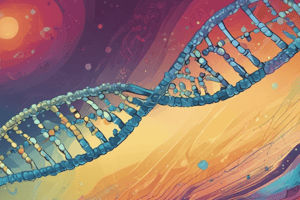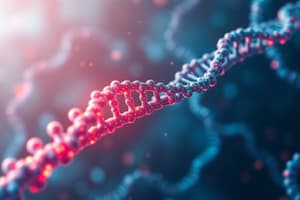Podcast
Questions and Answers
Which aspect of Frederick Sanger's background MOST significantly shaped his approach to scientific research, emphasizing both accuracy and moral considerations?
Which aspect of Frederick Sanger's background MOST significantly shaped his approach to scientific research, emphasizing both accuracy and moral considerations?
- His Quaker beliefs instilled by his father, emphasizing truth, conscience, and a pacifist stance. (correct)
- His father's profession as a rural general practice doctor, providing insights into practical problem-solving.
- His early exposure to natural history through his brother's interests, fostering a curiosity for the natural world.
- His decision to study natural sciences at Cambridge University, leading to his specialization in biochemistry.
Frederick Sanger's research methodology, which he self-identified as his greatest strength, is BEST characterized by which of the following approaches?
Frederick Sanger's research methodology, which he self-identified as his greatest strength, is BEST characterized by which of the following approaches?
- An emphasis on technological innovation, constantly seeking to employ the latest instrumentation.
- An experimental approach, characterized by meticulous laboratory work and innovative techniques. (correct)
- A theoretical approach, focusing on developing mathematical models to predict molecular behavior.
- A collaborative approach, leveraging insights and expertise from a diverse network of scientists.
What was the MOST significant outcome of Frederick Sanger's determination of the complete amino acid sequence of insulin?
What was the MOST significant outcome of Frederick Sanger's determination of the complete amino acid sequence of insulin?
- It led to the discovery of new types of amino acids, expanding our understanding of protein composition.
- It demonstrated the feasibility of sequencing proteins, paving the way for understanding their structures and functions. (correct)
- It facilitated the mass production of synthetic insulin, revolutionizing diabetes treatment.
- It revealed the role of insulin in glucose metabolism, clarifying the mechanisms of diabetes.
How did Frederick Sanger's personal values MOST directly influence his career trajectory during World War II?
How did Frederick Sanger's personal values MOST directly influence his career trajectory during World War II?
Which of the following represents the MOST profound and far-reaching impact of Sanger's development of the dideoxy method of DNA sequencing?
Which of the following represents the MOST profound and far-reaching impact of Sanger's development of the dideoxy method of DNA sequencing?
Sanger's shift from sequencing RNA to DNA was primarily motivated by which factor?
Sanger's shift from sequencing RNA to DNA was primarily motivated by which factor?
What key innovation enabled Sanger's team to overcome the challenges of sequencing DNA in 1977?
What key innovation enabled Sanger's team to overcome the challenges of sequencing DNA in 1977?
How did Sanger's development of the dideoxy sequencing method directly contribute to advancements in treating genetic disorders?
How did Sanger's development of the dideoxy sequencing method directly contribute to advancements in treating genetic disorders?
What was the MOST significant contribution of determining the mitochondrial DNA sequence?
What was the MOST significant contribution of determining the mitochondrial DNA sequence?
What critical advantage did Sanger gain that allowed him to focus on ambitious research goals, such as sequencing DNA, after 1958?
What critical advantage did Sanger gain that allowed him to focus on ambitious research goals, such as sequencing DNA, after 1958?
Flashcards
Frederick Sanger
Frederick Sanger
A British biochemist who pioneered methods for sequencing proteins, RNA, and DNA.
DNA Sequencing
DNA Sequencing
Determining the order of nucleotides in a DNA molecule.
Sanger Sequencing Method
Sanger Sequencing Method
Sanger's method for sequencing DNA, which revolutionized molecular biology.
Amino Acids
Amino Acids
Signup and view all the flashcards
Insulin
Insulin
Signup and view all the flashcards
DNA Double-Helix
DNA Double-Helix
Signup and view all the flashcards
RNA
RNA
Signup and view all the flashcards
Dideoxy Chain-Termination
Dideoxy Chain-Termination
Signup and view all the flashcards
John Sulston
John Sulston
Signup and view all the flashcards
DNA Fragments
DNA Fragments
Signup and view all the flashcards
Study Notes
- Frederick Sanger was an experimental biochemist who won the Nobel Prize twice.
- Sanger sequenced the components of proteins, RNA, and DNA.
- His DNA sequencing technique was revolutionary for molecular biology.
- It also ushered in a new era for medicine, gene therapy, and genetic manipulation.
- Sanger was born in Gloucestershire, UK, in 1918.
- Sanger's father was a doctor in a rural general practice.
- Sanger was influenced by his brother's interest in natural history.
- Sanger was also influenced by his father’s Quaker beliefs.
- He had a strong sense of truth and conscience from his father’s beliefs, and these beliefs would later infuse his scientific career.
- Sanger went to Cambridge University in 1936 to study natural sciences.
- He became interested in biochemistry there.
- He graduated in 1939 with an undergraduate degree.
Doctoral Research
- Sanger decided to study advanced biochemistry.
- His parents had both died while he was an undergraduate.
- He used money he had inherited from them, and in 1940, he began a self-funded PhD on the metabolism of amino acids.
- Amino acids are the basic chemical building blocks of proteins.
- He was exempted from military service during World War II due to his Quaker pacifism.
- Instead, he conducted applied research on nitrogen uptake in potatoes for the government.
- He received his PhD in 1943.
- Sanger cited the methodology of research as his greatest strength.
- He joined a group of scientists in Cambridge who were studying proteins.
- He spent the next decade attempting to decipher the complete amino acid sequence of insulin.
- The sequence was completed in 1955.
- Sanger also revealed that each protein possesses a unique set of amino acids and distinct 3D structure.
- Insulin was the first protein to be sequenced.
Nobel Award
- He received the 1958 Nobel Prize in Chemistry for his work on the chemical sequencing of insulin.
Genetic Research
- In 1962, Sanger moved to the Laboratory of Molecular Biology in Cambridge.
- Sanger aimed to untangle the double-helix structure of DNA to reveal the bases in specific strands of DNA
- He developed a sequencing method using radioactive isotopes to “label” individual fragments
- By 1967, he had a complete sequence of RNA from E. coli bacteria.
Sanger Sequencing
- In 1977, he published his dideoxy method of DNA sequencing, later known as “Sanger Sequencing.”
- The method isolates DNA fragments using a molecular inhibitor to prevent DNA strands from extending.
- The strands are ordered from shortest to longest so the base sequence can be read.
- By 1982, Sanger sequenced 48,502 base pairs of DNA.
- In 1981, he mapped the first human genome, the DNA of cell mitochondria.
Second Nobel Prize
- He shared the 1980 Nobel Prize in Chemistry with Walter Gilbert and Paul Berg for DNA sequencing.
- Sanger's sequencing method enabled fragments of DNA to be isolated, cloned, and reattached to create modified genes to treat—or be resistant to—genetic disorders.
Research Center
- He opened genome research center the Wellcome Sanger Institute in Cambridge, UK, in 1993.
- John Sulston was the first director of the Wellcome Sanger Institute.
- Sanger developed novel day-to-day laboratory techniques, such as micromethods for manipulating tiny volumes of chemicals.
Studying That Suits You
Use AI to generate personalized quizzes and flashcards to suit your learning preferences.
Description
Frederick Sanger was a biochemist known for sequencing the components of proteins, RNA, and DNA. His techniques revolutionized molecular biology. Sanger's technique ushered in a new era for medicine, gene therapy, and genetic manipulation. He was born in Gloucestershire, UK, in 1918 and later studied at Cambridge University.



